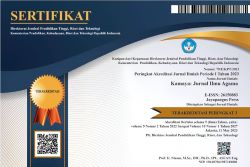Tradisi Mengirim Doa Dalam Bentuk Syoko Studi Deskriptif Pada Masyarakat Buddhis di Kabupaten Wonogiri
DOI:
https://doi.org/10.37329/kamaya.v5i3.1938Keywords:
Tradition, Send Prayer, Buddhist Society, SyokoAbstract
As a diverse country, Indonesia has various cultures that are believed and carried out for generations. One of the traditions carried out by the Buddhist community in Wonogiri is the tradition of sending prayers to deceased ancestors in the form of Syoko. The Buddhist community believes that the death of a person is not the end of life, so the bereaved family will perform various rituals to pray for the deceased family member. This study aims to describe how the Syoko tradition is carried out and what it means for people who carry out the Syoko tradition. By using a qualitative descriptive method, which was obtained through interviews and direct observation. From the results of the study, it can be explained that the Syoko Tradition carried out by the Buddhist community in Wonogiri has an important meaning. That is sending prayers to ancestors who have died, by sending prayers it is hoped that the living people can help ancestors who have died to go to a happy world of life. The arrangement of the altar which is different from the puja altar in general is that there is a photo of a person who has died in front of the Syoko altar, which aims to help condition the minds of the Buddhist community who praises remembering all the virtues that have been carried out by people who have died while still alive.
References
A. Ridho. (2019). Tradisi Megengan Dalam Menyambut Ramadhan (Living Qur’an Sebagai Kearifan Lokal Menyemai Islam di Jawa). Jurnal Literasiologi, 1(2), 24–48.
Aibak, K. (2010). Fenomena Tradisi Megengan di Tulungagung. Millah, 10(1), 68–86.
Andi Warisno. (2017). Tradisi Tahlilan Upaya Menyambung Silaturahmi Andi Warisno. Ri‟Ayah, 02, 69–79.
Asih, S. (2021). Kemasyarakatan Buddhis Sebagai Bentuk Struktur Dalam Agama Buddha (Sebuah Studi Kritis Pada Masyarakat Buddhis. Sabbhata Yatra, 2, 28–42.
Azisi, A. M. (2021). Konsep Kematian Dalam Perspektif Agama Buddha Theravada. Al-Adyan: Jurnal Studi Lintas Agama, 16(1), 95–118.
Bendung, L. (2013). Sangkan Paraning Dumadi Orang Jawa dan Rahasia Kematian. : Yogyakarta: Narasi.
Buddha, B. (2021). Mengenal lambang Dalam Agama Buddha. Kantor Kementerian Agama Kabupaten Pati. https://jateng.kemenag.go.id/2021/12/mengenal-lambang-dalam-agama-buddha/
Concepts, B. (2017). The Gohonzon. 1, 1–9.
Dzofir, M. (2017). Agama Dan Tradisi Lokal ( Studi Atas Pemaknaan Tradisi Rebo Wekasandi Desa Jepang, Mejobo, Kudus). IJTIMAIYA: Journal of Social Science Teaching, 1(1).
Hartaka, I. M. (2020). Ajaran Sivaisme dalam Teks Tatwa Jnana. Genta Hredaya, 4(2).
Karim, A. (2017). Makna Ritual Kematian Dalam Tradisi Islam Jawa. Sabda : Jurnal Kajian Kebudayaan, 12(2), 161.
Khairiah. (2018). Agama Buddha. Yogyakarta: Kalimedia.
Liu, W., Buddha, A., Kematian, D. A. N., & Liu, W. (2010). M. O’C. Walshe Willy Liu.
Marsini, Setiawan, P., & Sulaiman. (2021). Hubungan Sosial Masyarakat Buddhis Berlandaskan Dhamma. Jurnal Ilmu Agama Dan Pendidikan Agama Buddha, 3(1), 25–35.
Mukti, K. W. (2020). Wacana Buddha Dharma (v). Jakarta: Yayasan Karaniya.
Ningsih, A. F. (2018). Implikasi Tradisi Pattidana Terhadap Kematangan Beragama Umat Buddha Theravada Di Vihara Mendut, Kota Mungkid, Magelang, Jawa Tengah. Religi Jurnal Studi Agama-Agama, 13(2), 179.
Nyanaponika Thera, Piyadassi Thera, Bhikkhu Ñanajivako, Phra Khantipalo, Y. Karunadasa, B. Ñ. (2015). Tiga Fakta Dasar Eksistensi - I. Ketidakkekalan (Anicca) Judul. 137.
Pakar, S. I. (2015). Dzikir dan Ziarah. 81–83.
Pratiwi, K. B. (2019). Dari Ritual Menuju Komersial: Pergeseran Tradisi Ruwahan Di Kelurahan Sukorejo, Kecamatan Wonosari, Kabupaten Klaten. Haluan Sastra Budaya, 2(2), 204.
Shufya, F. H. (2022). Makna Simbolik Dalam Budaya “Megengan” Sebagai Tradisi Penyambutan Bulan Ramadhan (Studi Tentang Desa Kepet, Kecamatan Dagangan). Jurnal Ilmiah Dinamika Sosial, 6(1), 94–102.
Sugara, R. (2017). Reinterpretasi Konsep Bid’ah dan Fleksibilitas Hukum Islam Menurut Hasyim Asyari. As-Syariah, 19(1), 37–48.
Wanandar, R. M. D. E. M. (1994). Wahana Kehendak Buddha 30 Tahun Agama Buddha Nichiren Shoshu di Indonesia. Purwekerto: Yayasan Amerta.
Wardani, T. S., & Soebijantoro. (2017). “Upacara Adat Mantu Kucing di Desa Purworejo Kabupaten Pacitan: Makna Simbolis dan Potensinya sebagai Sumber Pembelajaran Sejarah.” Jurnal Agastya, 7(1), 66–81.
Yatno, T. (2019). Keterkaitan Tradisi Ulambana Dengan Penguatan Karakter Bangsa. Jurnal Vijjacariya, Volume 6 Nomor 1, Tahun 2019, 6, 113–127.
Downloads
Published
How to Cite
Issue
Section
License
Copyright (c) 2022 Kamaya: Jurnal Ilmu Agama

This work is licensed under a Creative Commons Attribution-ShareAlike 4.0 International License.
An author who publishes in the Kamaya : Jurnal Ilmu Agama agrees to the following terms:
- Author retains the copyright and grants the journal the right of first publication of the work simultaneously licensed under the Creative Commons Attribution-ShareAlike 4.0 License that allows others to share the work with an acknowledgement of the work's authorship and initial publication in this journal
- Author is able to enter into separate, additional contractual arrangements for the non-exclusive distribution of the journal's published version of the work (e.g., post it to an institutional repository or publish it in a book) with the acknowledgement of its initial publication in this journal.
- Author is permitted and encouraged to post his/her work online (e.g., in institutional repositories or on their website) prior to and during the submission process, as it can lead to productive exchanges, as well as earlier and greater citation of the published work (See The Effect of Open Access).
Read more about the Creative Commons Attribution-ShareAlike 4.0 Licence here: https://creativecommons.org/licenses/by-sa/4.0/.





